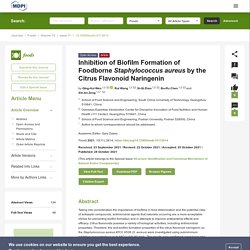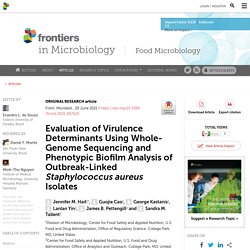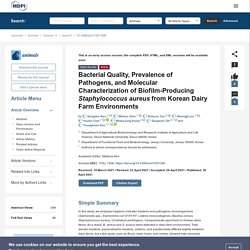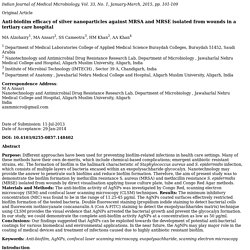

FOODS 28/10/21 Inhibition of Biofilm Formation of Foodborne Staphylococcus aureus by the Citrus Flavonoid Naringenin. Taking into consideration the importance of biofilms in food deterioration and the potential risks of antiseptic compounds, antimicrobial agents that naturally occurring are a more acceptable choice for preventing biofilm formation and in attempts to improve antibacterial effects and efficacy.

Citrus flavonoids possess a variety of biological activities, including antimicrobial properties. Therefore, the anti-biofilm formation properties of the citrus flavonoid naringenin on the Staphylococcus aureus ATCC 6538 (S. aureus) were investigated using subminimum inhibitory concentrations (sub-MICs) of 5~60 mg/L. The results were confirmed using laser and scanning electron microscopy techniques, which revealed that the thick coating of S. aureus biofilms became thinner and finally separated into individual colonies when exposed to naringenin.
MICROORGANISMS 19/07/21 Research on the Biofilm Formation of Staphylococcus aureus after Cold Stress. Staphylococcus aureus is a common food pathogen and has a strong tolerance to environmental stress.

Here, the biofilm formation of S. aureus strains after cold stress for 24 weeks were investigated. It was found that the biofilm formation of S. aureus CICC 21600, CICC 22942, W1, W3, and C1 cells was enhanced after cold stress for 20 weeks. What is more, the mRNA levels of the clfA, icaA, icaB, icaC or icaD genes in these strains were increased for >2-fold. The increased gene transcription levels were consistent with the increase in the polysaccharide content in the biofilm matrix of these S. aureus strains after cold stress. Meanwhile, hydrophobicity and the adhesion proteins also played a role in the formation of biofilms. ►▼ Show Figures. FRONT. MICROBIOL. 29/06/21 Evaluation of Virulence Determinants Using Whole-Genome Sequencing and Phenotypic Biofilm Analysis of Outbreak-Linked Staphylococcus aureus Isolates. Introduction.

ANIMALS 30/04/21 Bacterial Quality, Prevalence of Pathogens, and Molecular Characterization of Biofilm-Producing Staphylococcus aureus from Korean Dairy Farm Environments. This is an early access version, the complete PDF, HTML, and XML versions will be available soon.

Open AccessArticle. UNIVERSITY OF PARMA - 2018 - Thèse en ligne: Food-Related Staphylococcus aureus Biofilms: Characterization and Control. ANTIBIOTICS 04/10/19 Methods Used for the Eradication of Staphylococcal Biofilms. Staphylococcus aureus is considered one of the leading pathogens responsible for community and healthcare-associated infections.

Among them, infections caused by methicillin-resistant strains (MRSA) are connected with ineffective or prolonged treatment. The therapy of staphylococcal infections faces many difficulties, not only because of the bacteria’s resistance to antibiotics and the multiplicity of virulence factors it produces, but also due to its ability to form a biofilm. The present review focuses on several approaches used for the assessment of staphylococcal biofilm eradication. The methods described here are successfully applied in research on the prevention of biofilm-associated infections, as well as in their management. They include not only the evaluation of the antimicrobial activity of novel compounds, but also the methods for biomaterial functionalization. Brazilian Journal of Microbiology Volume 48, Issue 1, January–March 2017, Biofilm production and beta-lactamic resistance in Brazilian Staphylococcus aureus isolates from bovine mastitis.
Abstract Staphylococcus spp. play an important role in the etiology of bovine mastitis.

Staphylococcus aureus is considered the most relevant species due to the production of virulence factors such as slime, which is required for biofilm formation. This study aimed to evaluate biofilm production and its possible relation to beta-lactamic resistance in 20 S. aureus isolates from bovine mastitic milk. The isolates were characterized by pheno-genotypic and MALDI TOF-MS assays and tested for genes such as icaA, icaD, bap, agr RNAIII, agr I, agr II, agr III, and agr IV, which are related to slime production and its regulation. Biofilm production in microplates was evaluated considering the intervals determined along the bacterial growth curve. Inox et biofilm et Staphylococcus. Research in Microbiology Volume 168, Issue 1, January 2017, Methicillin-resistant food-related Staphylococcus aureus: a review of current knowledge and biofilm formation for future studies and applications. Abstract There is increasing concern about the public health impact of methicillin-resistant Staphylococcus aureus.

Food and animal are vectors of transmission, but the contribution of a contaminated environment is not well characterized. With regard to this, staphylococcal biofilms serve as a virulence factor, allowing MRSA strains to adhere to surfaces and other materials used in the food industry. Methicillin resistance and biofilm-forming capacity may contribute to the success of S. aureus as a human pathogen in both health care and community settings and the food production chain.
Food Control Volume 73, Part B, March 2017, Biofilm formation by Salmonella Typhimurium and Staphylococcus aureus on stainless steel under either mono- or dual-species multi-strain conditions and resistance of sessile communities to sub-lethal chemical di. Highlights S. enterica and S. aureus formed mono- and dual-species biofilms on stainless steel.

Both bacterial species formed less biofilm (ca. 10-fold) under co-culture. Resistance of each species was not influenced by interspecies interactions. Bacterial interactions influenced both dominance and resistance of each strain. Front Microbiol. 2016; 7: 390. Compositional Analysis of Biofilms Formed by Staphylococcus aureus Isolated from Food Sources. Journal of Hospital Infection 78 (2011) 204e207 Disinfection of meticillin-resistant Staphylococcus aureus and Staphylococcus epidermidis biofilms using a remote non-thermal gas plasma.
Journal of Hospital Infection 80 (2012) 61e66 Reduction of surface contamination and biofilms of Enterococcus sp. and Staphylococcus aureus using a citrus-based vapour. A De Montfort University, School of Pharmacy, Faculty of Health and Life Science, Leicester, UKb University of Northampton, School of Health, Northampton, UK Received 30 November 2010, Accepted 8 April 2011, Available online 6 December 2011.

Indian Journal of Medical Microbiology, Vol. 33, No. 1, January-March, 2015, pp. 101-109 Anti-biofilm efficacy of silver nanoparticles against MRSA and MRSE isolated from wounds in a tertiary care hospital. Indian Journal of Medical Microbiology, Vol. 33, No. 1, January-March, 2015, pp. 101-109 Original Article Anti-biofilm efficacy of silver nanoparticles against MRSA and MRSE isolated from wounds in a tertiary care hospital MA Alzohairy1, MA Ansari2, SS Cameotra3, HM Khan2, AA Khan4 1 Department of Medical Laboratories College of Applied Medical Science Buraydah Colleges, Buraydah 51452, Saudi Arabia2 Nanotechnology and Antimicrobial Drug Resistance Research Lab, Department of Microbiology , Jawaharlal Nehru Medical College and Hospital, Aligarh Muslim University, Aligarh, India3 Institute of Microbial Technology (IMTECH) , Sector 39 A, Chandigarh, India4 Department of Anatomy , Jawaharlal Nehru Medical College and Hospital, Aligarh Muslim University, Aligarh, India.

Int J Food Microbiol. 2015 Dec 2;214:38-47. Impact of growth temperature and surface type on the resistance of Pseudomonas aeruginosa and Staphylococcus aureus biofilms to disinfectants. Mater Sci Eng C Mater Biol Appl. 2015 Jun;51:356-61. Anti-biofilm formation of a novel stainless steel against Staphylococcus aureus. Open Access Abstract Staphylococcus aureus (S. aureus) is a bacterium frequently found proliferating on metal surfaces such as stainless steels used in healthcare and food processing facilities.
Past research has shown that a novel Cu-bearing 304 type stainless steel (304CuSS) exhibits excellent antibacterial ability (i.e. against S. aureus) in a short time period (24 h.). This work was dedicated to investigate the 304CuSS's inhibition ability towards the S. aureus biofilm formation for an extended period of 7 days after incubation. It was found that the antibacterial rate of the 304CuSS against sessile bacterial cells reached over 99.9% in comparison with the 304SS. J Food Sci. 2015 Oct;80(10):M2279-86. Biofilm Formation of Staphylococcus aureus on Various Surfaces and Their Resistance to Chlorine Sanitizer.
Food Control. 11/2014; Biofilm formation by Staphylococcus aureus on food contact surfaces: Relationship with temperature and cell surface hydrophobicity. AFRICAN JOURNAL OF MICROBIOLOGY RESEARCH Vol.8(36), pp. 3347-3353 , September 2014 Action of sanitizers on Staphylococcus aureus biofilm on stainless steel and polypropylene surfaces. The interest of researchers in various areas has resulted in the investigation of different biofilm systems using a wide range of techniques. Biofilms are microbial communities consisting of mono or multi-species sessile cells, embedded in a matrix of extracellular polymers (exopolysaccharides-EPS) adhering to surfaces. In the food industry, the existence of biofilms is quite problematic, being responsible for the economic loss and contamination of food. Consequently, research involving the characterization of the ability of microbial biofilm formation is relevant for the subsequent studies using sanitizing and antibiotic agents for prevention or remediation of surfaces with already formed biofilms.
Key words: Antimicrobial effect, microorganism, Syzygium aromaticum, Thymus vulgaris. Microorganisms have been evolving for approximately 4 billion years, and up to 2 billion years ago they were the only life forms on Earth. DIGITAL_CSIC_ES - 2014 - Thèse en ligne : Assessment of control strategies against Staphylococcus aureus biofilms potentially present in the fishery industry. NOFIMA - 2003 - Biofilm formation and presence of the intercellular adhesion locus ica among staphylococci from food and food processing environments.
MOLECULAR MICROBIOLOGY RESEARCH - 2013 - Biofilm Producing Staphylococcus aureus and Bovine Mastitis: A Review. IOSR Journal of Pharmacy and Biological Sciences - NOV 2013 - Staphylococcus aureus and Pseudomonas aeruginosa- Biofilm formatio. Indian Journal of Basic and Applied Medical Research - December 2013 - Biofilm formation and antibiotic susceptibility pattern i. Biofilm Producing Staphylococcus aureus and Bovine Mastitis: A Review. Braz. J. Microbiol. vol.44 no.1 São Paulo 2013 Epub May 17, 2013 Comparison of methods for the detection of biofilm formation by. Comparison of methods for the detection of biofilm formation by Staphylococcus aureus isolated from bovine subclinical mastitis Poliana de Castro MeloI; Luciano Menezes FerreiraI; Antônio Nader FilhoI; Luiz Francisco ZafalonII; Hinig Isa Godoy VicenteIII; Viviane de SouzaIV IDepartamento de Medicina Veterinária Preventiva, Universidade Estadual Paulista "Júlio de Mesquita Filho", Jaboticabal, SP, Brazil.
Braz. J. Microbiol. vol.44 no.1 São Paulo 2013 Epub May 17, 2013 Comparison of methods for the detection of biofilm formation by Staphylococcus aureus isolated from bovine subclinical mastitis – guatemalt
African Journal of Microbiology Research 12/07/13 Biofilm, protease and lipase properties and antibiotic resistance profiles of.
African Journal of Microbiology Research 12/07/13 Biofilm, protease and lipase properties and antibiotic resistance profiles of staphylococci isolated from various foods – guatemalt
The Scientific World Journal - 2013 - Investigation of Biofilm Forming Ability in Staphylococci Causing Bovine Mastitis Using Ph.
The Scientific World Journal - 2013 - Investigation of Biofilm Forming Ability in Staphylococci Causing Bovine Mastitis Using Phenotypic and Genotypic Assays – guatemalt
African Journal of Microbiology Research Vol. 6(13), pp. 3284-3291, 9 April, 2012 Growth properties of Staphylococcus aureus in. MEM INST OSWALDO CRUZ, RIO DE JANEIRO, 106(1) February 2011 High vancomycin resistance among biofilms produced by Staphylococcus.
MEM INST OSWALDO CRUZ, RIO DE JANEIRO, 106(1) February 2011 High vancomycin resistance among biofilms produced by Staphylococcus species isolated from central venous catheters – guatemalt
African Journal of Biotechnology Vol. 10(57), pp. 12125-12133, 28 September, 2011 Assessment of antibiotic susceptibilities, gen. African Journal of Biotechnology Vol. 10(65), pp. 14625-14636, 24 October, 2011 Biofilm production and antibiotic susceptibility. Biofilm production and antibiotic susceptibility profiles of Staphylococcus aureus isolated from HIV and AIDS patients in the Limpopo Province, South Africa Abstract Staphylococcus aureus is a common pathogen associated with nosocomial as well as community acquired infections. Despite multiple reports on the severity and recurrent nature of S. aureus infection, the pathogenesis as well as antibiotic susceptibility profiles of S. aureus infecting HIV and AIDS patients has not been well studied in Limpopo Province, South Africa. Hence, the study was aimed at determining the biofilm producing capability and antibiotic resistance profiles of the S. aureus isolated from drinking water and clinical samples from HIV patients in the Limpopo Province.
Microbiology (2008), 154, 3224–3231 Vancomycin heteroresistance and biofilm formation in Staphylococcus epidermidis from food. PLOS - NOV 2009 - Molecular Characterization of a Novel Staphylococcus Aureus Surface Protein (SasC) Involved in Cell Aggregatio. Background Staphylococci belong to the most important pathogens causing implant-associated infections. Colonization of the implanted medical devices by the formation of a three-dimensional structure made of bacteria and host material called biofilm is considered the most critical factor in these infections.
To form a biofilm, bacteria first attach to the surface of the medical device, and then proliferate and accumulate into multilayered cell clusters. Biofilm accumulation may be mediated by polysaccharide and protein factors. Methology/Principal Findings The information on Staphylococcus aureus protein factors involved in biofilm accumulation is limited, therefore, we searched the S. aureus Col genome for LPXTG-motif containing potential surface proteins and chose the so far uncharacterized S. aureus surface protein C (SasC) for further investigation. Conclusions/Significance Figures Editor: Holger Bruggemann, Max Planck Institute for Infection Biology, Germany. Rev Esp Quimioter 2012;25(1):10-16 Macrolides and staphylococcal biofilms. Food Control Volume 25, Issue 2, June 2012, Influence of temperature and surface kind on biofilm formation by Staphylococcus aur. Open Access Abstract This study aimed to assess the adhesion, detachment kinetic and biofilm formation of Staphylococcus aureus isolates from food services surfaces on stainless steel and polypropylene surfaces when cultivated in a vegetable-based broth at 7 and 28 °C, and the efficacy of peracetic acid (30 mg/L) and sodium hypochlorite (250 mg/L) in removing the bacterial cells from the matrix of the preformed biofilm.
The isolates adhered over 4 Log cfu/cm2 regardless the surface kind and incubation temperature. Cell detachment was around 3 Log cfu/cm2 over the first six contacts with agar characterizing a high persistence of cells on the tested surfaces. Number of cells (5–7 Log cfu/cm2) needed for biofilm formation was noted at all experimental systems already after 3 days of incubation. Highlights Keywords. Traduction du résumé en français (source BIBLIOMER) L'adresse du site bibliomer change. FEMS Immunol Med Microbiol. 2010 August; 59(3): 306–323. Vaccine development in Staphylococcus aureus: taking the biofilm phenot. Evidence-Based Complementary and Alternative Medicine Volume 2012 (2012) Inhibition of Staphylococcus epidermidis Biofilm Format. Czech J. Food Sci. Vol. 29, 2011, Special Issue: S1–S10 Antimicrobial Factors Effects on Biofilm Formation in Staphylococcus aur. Curr Top Microbiol Immunol. 2008; 322: 207–228. Staphylococcal Biofilms. Current Microbiology 14/10/12 Impact of Food-Related Environmental Factors on the Adherence and Biofilm Formation of Natural Sta.
Braz. J. Microbiol. vol.41 no.4 São Paulo Oct./Dec. 2010 Quantification of biofilm production on polystyrene by Listeria, Escher. Quantification of biofilm production on polystyrene by Listeria, Escherichia coli and Staphylococcus aureus isolated from a poultry slaughterhouse Laura Beatriz RodriguesI, II, *; Luciana Ruschel dos SantosI; Vinícius Zancanaro TagliariI; Natalie Nadin RizzoI; Graciela TrenhagoI; Amauri Picollo de OliveiraI; Franciane GoetzI; Vladimir Pinheiro do NascimentoII. BMC Microbiology 2009, 9:229 Staphylococcus aureus biofilm formation at the physiologic glucose concentration depends on the S. Biofilms (2004) 1, 65–73 Combined effect of chelating agents and ultrasound on biofilm removal from stainless steel surfaces. Ap.